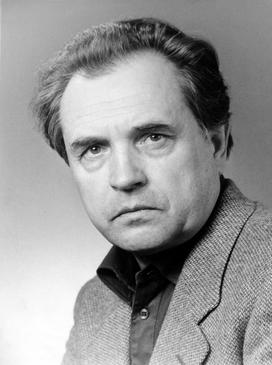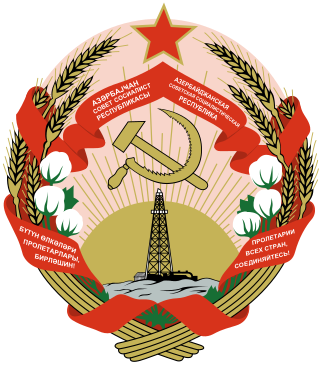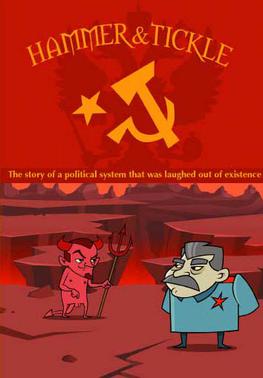The intelligentsia is a status class composed of the university-educated people of a society who engage in the complex mental labours by which they critique, shape, and lead in the politics, policies, and culture of their society; as such, the intelligentsia consists of scholars, academics, teachers, journalists, and literary writers.
The 1936 Constitution of the Soviet Union, also known as the Stalin Constitution, was the constitution of the Soviet Union adopted on 5 December 1936.
Russian humour gains much of its wit from the inflection of the Russian language, allowing for plays on words and unexpected associations. As with any other culture's humour, its vast scope ranges from lewd jokes and wordplay to political satire.
Russian jokes are short fictional stories or dialogs with a punch line, which commonly appear in Russian humor. Russian joke culture includes a series of categories with fixed settings and characters. Russian jokes treat topics found everywhere in the world, including sex, politics, spousal relations, or mothers-in-law. This article discusses Russian joke subjects that are particular to Russian or Soviet culture.

The emblems of the constituent republics of the Union of Soviet Socialist Republics all featured predominantly the hammer and sickle and the red star that symbolized communism, as well as a rising sun, surrounded by a wreath of wheat. The USSR State motto, Workers of the world, unite!, in both the republic's language and Russian was also placed on each one of them. In addition to those repetitive motifs, emblems of many Soviet republics also included features that were characteristic of their local landscapes, economies or cultures.
East German jokes, jibes popular in the former German Democratic Republic, reflected the concerns of East German citizens and residents between 1949 and 1990. Jokes frequently targeted political figures, such as Socialist Party General Secretary Erich Honecker or State Security Minister Erich Mielke, who headed the Stasi secret police. Elements of daily life, such as economic scarcity, relations between the GDR and the Soviet Union, or Cold War rival, the United States, were also common. There were also ethnic jokes, highlighting differences of language or culture between Saxony and Central Germany.
Romanian humour, like many other Romanian cultural aspects, has many affinities with four other groups: the Latins, the Balkan people, the Germans and the Hungarians.

Alexander Alexandrovich Zinoviev was a Soviet philosopher, writer, sociologist, and journalist.
Russian political jokes are a part of Russian humour and can be grouped into the major time periods: Imperial Russia, Soviet Union and post-Soviet Russia. In the Soviet period political jokes were a form of social protest, mocking and criticising leaders, the system and its ideology, myths and rites. Quite a few political themes can be found among other standard categories of Russian joke, most notably Rabinovich jokes and Radio Yerevan.

The national emblem of the Azerbaijan Soviet Socialist Republic was adopted in 1937 by the government of the Azerbaijan Soviet Socialist Republic. The style is based on the emblem of the Soviet Union.

The coat of arms of the Georgian Soviet Socialist Republic was adopted on May 20, 1921 by the government of the Georgian Soviet Socialist Republic. The coat of arms is loosely based on the coat of arms of the Soviet Union. It shows symbols of agriculture. The red star rising above the Caucasus stands for the future of the Georgian nation, and the hammer and sickle for the victory of Communism and the "world-wide socialist community of states".

The State Emblem of the Tajik Soviet Socialist Republic was adopted on March 1, 1937 by the government of the Tajik Soviet Socialist Republic. The emblem is based on the State Emblem of the Soviet Union. It shows symbols of agriculture. The red star is prominently featured with a small hammer and sickle within it. The rising sun stands for the future of the Tajik nation, and the star as well as the hammer and sickle for the victory of communism and the "world-wide socialist community of states". The emblem was replaced with the new emblem in 1992, which uses a similar design to the Soviet one. It was, however, was replacing the red banner with the current national flag, the big red star was replaced by the mountains, represents Pamir, the Samanid dynasty crown, and added the Quran book at below. It represents Islam as the official religion.

The Emblem of the Turkmen Soviet Socialist Republic was adopted on 2 March 1937 by the government of the Turkmen Soviet Socialist Republic. The coat of arms is based on the coat of arms of the Soviet Union. It shows symbols of agriculture and heavy industry, as well as a symbol of the Turkmen people, a rug. The rising Sun stands for the future of the Turkmen nation, the red star as well as the hammer and sickle for the victory of Communism and the "world-wide socialist community of states".

The coat of arms of the Moldavian Soviet Socialist Republic was adopted on 10 February 1941 by the government of the Moldavian Soviet Socialist Republic. The coat of arms is based on the coat of arms of the Soviet Union. It shows symbols of agriculture, an outer rim featuring wheat, corn, grapes and clover. The red banner bears the Soviet Union state motto in both the Romanian language and the Russian language. In Romanian, it was initially "Пролетарь дин тоате цэриле, униць-вэ!"; then, from the 1950s "Пролетарь дин тоате цэриле, уници-вэ!". Both are written in the Latin alphabet as "Proletari din toate țările, uniți-vă!". The acronym MSSR is shown only in Romanian in Moldovan Cyrillic ("РССМ"). The emblem was replaced on 3 November 1990 by the present coat of arms of Moldova. Currently, the unrecognized breakaway state of Transnistria uses a similar state emblem.

Hammer & Tickle: The Communist Joke Book is a 2006 documentary film about the nature of Russian political jokes under the powerful and socially restrictive Communist regime of the Soviet Union and its satellite nations. The film's name exemplifies the kind of mockery or criticism of the regime that the Soviet government would have found to be disagreeable by playing on the symbol of communism itself, the hammer and sickle. The film tells the story of the power that jokes had to enable social and political change and advance personal freedoms from within the USSR - the film's opening scene uses a quote from George Orwell's 1984: "Every joke is a tiny revolution."

The State Emblem of the Soviet Union was adopted in 1923 and was used until the dissolution of the Soviet Union in 1991. Although it technically is an emblem rather than a coat of arms, since it does not follow traditional heraldic rules, in Russian it is called герб, the word used for a traditional coat of arms.
Communist symbolism represents a variety of themes, including revolution, the proletariat, the peasantry, agriculture, or international solidarity. The red flag, the hammer and sickle and the red star or variations thereof are some of the symbols adopted by communist movements, governments, and parties worldwide.
Ben Lewis is a British art critic, historian and documentary filmmaker.
Hammer and Tickle may refer to:
Nogai writing is a script used to write the Nogai language. During its existence, it has changed its graphic basis several times. Currently, the Nogai script functions in the Cyrillic alphabet. There are 3 stages in the history of Nogai writing:









